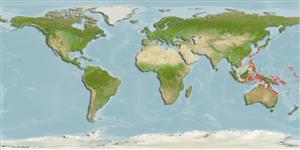Common names from other countries
Teleostei (teleosts) >
Perciformes/Uranoscopoidei (Sand dwellers) >
Pinguipedidae (Sandperches)
Etymology: Parapercis: Greek, para = the side of + Greek, perke = perch (Ref. 45335); pacifica: Named for its distribution in the Pacific..
Environment: milieu / climate zone / depth range / distribution range
Ecology
Marine; benthopelagic; depth range 0 - 6 m (Ref. 75058). Subtropical
Western Pacific: southern Japan to Indonesia.
Size / Weight / Age
Maturity: Lm ? range ? - ? cm
Max length : 18.6 cm SL male/unsexed; (Ref. 75058); 13.1 cm SL (female)
Short description
Morphology | Morphometrics
Dorsal
spines
(total): 5;
Dorsal
soft rays
(total): 21-22;
Anal
spines: 1;
Anal
soft rays: 17 - 18. This species is distinguished by the following: pectoral fin rays usually 18; cheek region with brown semicircular or M-shaped band and many blackish spots; lower portion of the
body in males with 3-4 ocelli and several blackish and brownish spots; usually 1-2 A1-2 and A2-3 spots, 2-3 A' series spots, and B4 spot, and a series of 6-7 ocelli on the lower portion of the body with brownish spots or patches between them present in females and juveniles (Ref. 75058).
Life cycle and mating behavior
Maturity | Reproduction | Spawning | Eggs | Fecundity | Larvae
Imamura, H. and T. Yoshino, 2007. Three new species of the genus Parapercis from the Western Pacific, with Rediscription of Parapercis hexophtalma (Perciformes:Pinguipedidae). Bull. Natl. Mus. Nat. Sci. Ser. A, Suppl. 1:81-100. (Ref. 75058)
IUCN Red List Status (Ref. 130435)
CITES (Ref. 128078)
Not Evaluated
Threat to humans
Harmless
Human uses
More information
Common namesSynonymsMetabolismPredatorsEcotoxicologyReproductionMaturitySpawningFecundityEggsEgg development
Age/SizeGrowthLength-weightLength-lengthLength-frequenciesMorphometricsMorphologyLarvaeLarval dynamicsRecruitmentAbundance
ReferencesAquacultureAquaculture profileStrainsGeneticsElectrophoresesHeritabilityDiseasesProcessingMass conversion
Tools
Special reports
Download XML
Internet sources
Estimates based on models
Preferred temperature (Ref.
115969): 25.1 - 29.3, mean 28.7 (based on 956 cells).
Phylogenetic diversity index (Ref.
82804): PD
50 = 0.5000 [Uniqueness, from 0.5 = low to 2.0 = high].
Bayesian length-weight: a=0.00692 (0.00311 - 0.01538), b=3.06 (2.88 - 3.24), in cm Total Length, based on LWR estimates for this Genus-body shape (Ref.
93245).
Trophic level (Ref.
69278): 3.6 ±0.4 se; based on size and trophs of closest relatives
Resilience (Ref.
120179): High, minimum population doubling time less than 15 months (Preliminary K or Fecundity.).
Fishing Vulnerability (Ref.
59153): Low vulnerability (13 of 100).
